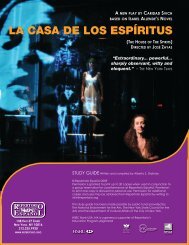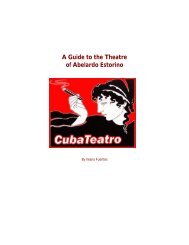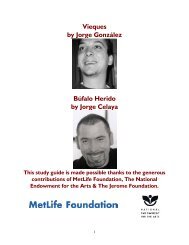You also want an ePaper? Increase the reach of your titles
YUMPU automatically turns print PDFs into web optimized ePapers that Google loves.
From there the invaders could readily exploit<br />
the gold in the Cibao River, a short distance away<br />
upstream. The Spaniards brought with them horses<br />
and dogs, and combined with their armor and iron<br />
weapons, they posed an occupation force that the<br />
peace-loving taínos were unable to defeat.<br />
The Western third of the island became a<br />
French possession in 1697, and over the next century<br />
developed Saint-Domingue into what became by<br />
far the richest colony in the world. The wealth of<br />
this colony stemmed primarily from sugar.<br />
Hundreds of thousands of African slaves were<br />
imported from Africa to work in those plantations,<br />
where they were brutally treated.<br />
Between 1795 and 1821, both Spain and<br />
France ruled the island intermittently. In 1821, the<br />
first independence from Spain was achieved, cut<br />
short by the Haitian occupation of 1822, which lasted<br />
until 1844. Haiti had become an independent<br />
country in 1804. The great national leader, Juan<br />
Pablo Duarte led the Dominicans against the<br />
Haitians. But by 1861, General Pedro Santana was<br />
inviting the Spanish to return to their former<br />
colony and take over control. After a short period<br />
of mismanagement, the Dominicans quickly realized<br />
their mistake and forced the Spanish out.<br />
During the 19th century the country's economy<br />
shifted from primarily livestock grazing to<br />
other sources of revenue. In the southwestern<br />
region, a new industry sprung up: cutting down and<br />
exporting precious woods such as mahogany, oak<br />
and guaiacum. In the northern plains and valleys<br />
around Santiago, the emphasis was on growing<br />
tobacco, an activity that yielded some of the world's<br />
best cigars. Throughout the country, coffee was<br />
another important crop.<br />
In 1905, the U.S. took over the administration<br />
of the customs revenues of the Dominican<br />
Republic, presumably to outmaneuver other<br />
European creditors. With the advent of the First<br />
World War, political instability raised fears and the<br />
United States sent in its Marines to occupy the<br />
country in 1916. Only a few months earlier, the<br />
Americans had occupied Haiti. The US occupation<br />
lasted eight years in the Dominican Republic, 19<br />
years in Haiti.<br />
One of the changes implemented by the<br />
U.S. was to establish a trained national army to<br />
maintain law and order and uphold public safety.<br />
During the occupation, U.S. Marines established<br />
the Dominican National Guard. A former telegraph<br />
clerk named Rafael Leónidas Trujillo joined the<br />
new force and excelled in the ranks; the Americans<br />
chose him to head the police in 1924. The country<br />
had its first relatively free election after the U.S.<br />
forces withdrew that year; but Trujillo staged a military<br />
coup in 1930, overthrowing president Horacio<br />
Vázquez, and proclaiming himself head of state.<br />
There is no question that Trujillo reached out to his<br />
people, created jobs, paid off the national debt,<br />
strengthened the sugar industry and improved the<br />
general standard of living in the first years of his<br />
rule. Dominicans worshiped him like a deity.<br />
Trujillo always made it clear that he was a<br />
racist –even though his mother was a mulatto<br />
woman with African slave ancestry- and he considered<br />
Black Haitians inferior and a threat to<br />
Dominican integrity. This feeling was echoed in<br />
most Dominican homes, in spite of the fact that<br />
about 70% of the population at the time were<br />
mulattoes and 11% Black. In 1937 he ordered his<br />
army to massacre all Haitians found illegally within<br />
Dominican territory, especially those near the border<br />
with Haiti. In Dajabón alone, some 15,000<br />
Haitians were killed. However, during the peace<br />
negotiations –headed by Trujillo’s president Joaquin<br />
Balaguer on the Dominican side of the table- an<br />
official figure of 2,750 casualties was "agreed upon."<br />
The Dominican government compensated its<br />
Haitian counterpart in cash.<br />
Trujillo remained in power for over 30 years,<br />
but toward the end he succeeded in alienating even<br />
his most avid supporters, including the United<br />
States and the Catholic Church.<br />





